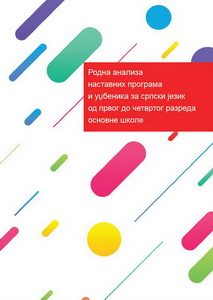 The Social Inclusion and Poverty Reduction Unit of the Government of the Republic of Serbia, in cooperation with the Coordination Body for Gender Equality of the Government of the Republic of Serbia, conducted a review of the curricula and textbooks for the subject Serbian Language for I to IV grade of primary school, to examine the inclusion of a gender perspective in the teaching materials and documents used to programme classes.
The Social Inclusion and Poverty Reduction Unit of the Government of the Republic of Serbia, in cooperation with the Coordination Body for Gender Equality of the Government of the Republic of Serbia, conducted a review of the curricula and textbooks for the subject Serbian Language for I to IV grade of primary school, to examine the inclusion of a gender perspective in the teaching materials and documents used to programme classes.
The review was conducted during October 2017 – June 2018, covering the curricula of I to IV grade and textbook sets by three publishers whose textbooks are mainly in use in schools across Serbia (Klett, Eduka and Novi Logos). The subject Serbian Language was chosen because it has the highest number of classes and covers topics related to diverse aspects of social and family life conducive to promoting a discussion on the status of women, gender roles and stereotypes.
The review has shown that the concept of gender equality is not included in the conceptual apparatus in neither the curricula nor the textbooks for the first four grades of primary school. None of the content on offer covers the topic of gender equality in name, nor does covering such content involve explanations about the conditions for the development of gender equality or sources of gender inequality in our society.
Gender inequality is also reflected in the great disproportion of the number of male and female authors whose works are covered by the textbooks (in favour of males), the higher presence of male characters in texts and in illustrations compared to female characters, where the male characters are mainly the principal characters of the texts, they set the plot in motion and resolve it. Furthermore, the textbooks present a wider selection of professions, characteristics, values and interests for male characters than females.
As shown by this review, despite the existence of positive examples in textbooks and teaching sheets, such as the use of gender neutral or gender sensitive language, the showing of male-female pairs in non-stereotypical activities, the participation of both boys and girls in housework, and showing girls in sports outfits and with medals around their necks, it is clear that additional efforts are needed to enrich the teaching materials with gender relevant content that would promote discussion and encourage students to take a critical stance towards the structural foundations of gender relations in our society.
 Government of the Republic of Serbia
Government of the Republic of Serbia















 pdf [271 KB]
pdf [271 KB]
Leave a Comment